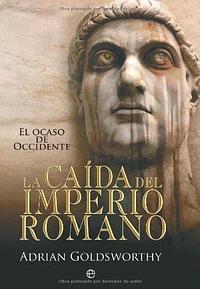Take a photo of a barcode or cover
challenging
informative
reflective
slow-paced
informative
slow-paced
3.5 or so. Maybe a bit over. Analysis seemed iffy, lots of biases showing through (especially in the completely unasked for comparison to modern America). But a good chronological history with nice scope, attention to detail, and some attempt to view the history from multiple perspectives.
It was a well written and engaging book. At times it felt like he might be strawmanning slightly though in his assertions which seemed very "This used to be believed, but academia has over corrected in the other direction, and only I am the one who is offering the correct, balanced understanding!"
Ensayo perfecto tanto para iniciados como duchos en la materia. El autor repasa la historia política, pero también la social, económica y bélica desde Cómodo hasta la época de Justiniano y Belisario.
Exceptional overview of the history of the decline and fall of the Roman Empire. Starts all the way in the reign of Marcus Aurelius, and so it covers basically everything sufficiently important -- the first plague to hit the empire in the reign of Marcus, the Third Century Crisis (though I found it odd that the Plague of Cyprian in the 260's and 70's wasn't mentioned), the Tetrarchy and Constantine's rise and how the capitals of the empire shifted during this period, the slow rift into the Eastern (later called Byzantine) and Western empires, etc, etc, etc. I learned an enormous sum.
I would also recommend reading this right after Mary Beard's SPQR: A History of Ancient Rome (which starts from the Roman Kingdom and ends during the reign of Caracalla, and so the two books provide a basic continuum of the history of Rome in its entirety, excluding the continuing Byzantine empire).
I would also recommend reading this right after Mary Beard's SPQR: A History of Ancient Rome (which starts from the Roman Kingdom and ends during the reign of Caracalla, and so the two books provide a basic continuum of the history of Rome in its entirety, excluding the continuing Byzantine empire).
informative
medium-paced
Interessante inzichten in de Romeinse cultuur en ellenlange reeksen van opstanden, burgeroorlogen en veldslagen. Ik ben blij dat ik het heb gelezen, maar ik ga het niet nog een keer doen!
Goldsworthy picks up the story of the Roman Empire at the end of the reign of Marcus Aurelius, the last of the five good emperors. In order to tell the best story of how Rome fell, the best place to start is when Rome is at its height. He then takes us through the tumultuous time from 235-284 when emperor after emperor reigned for short times. Of course Diocletian and Constantine get their screentime before moving to the end of the west in the 400s and finishing the story with the east about to face the rise of Islam.
So why did Rome fall? Goldsworthy emphasizes the internal problems of continuous civil war. It was not repeated barbarian invasions that brought Rome to her knees, for even late in the game Rome could beat back the barbarians if they wanted to. By "wanted to" you might substitute "able to put together a united front". Unfortunately they fought themselves over and over which weakened them, eventually beyond the point of no return.
I definitely want to read more of Goldsworthy's works now. For any fan of Roman history, this is a great read.
So why did Rome fall? Goldsworthy emphasizes the internal problems of continuous civil war. It was not repeated barbarian invasions that brought Rome to her knees, for even late in the game Rome could beat back the barbarians if they wanted to. By "wanted to" you might substitute "able to put together a united front". Unfortunately they fought themselves over and over which weakened them, eventually beyond the point of no return.
I definitely want to read more of Goldsworthy's works now. For any fan of Roman history, this is a great read.
Occasionally repetitive (almost like a reality tv show, with recaps of previous events in the exact same language), but overall very good!




